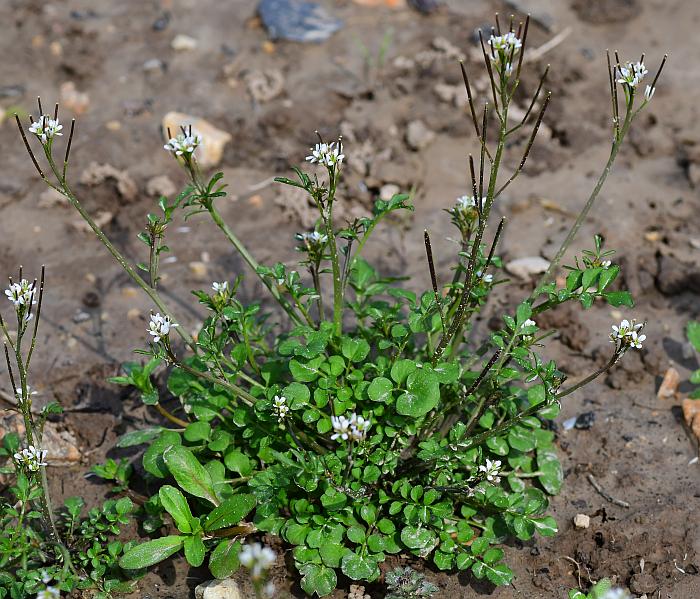Cardamine hirsuta L.
Hoary Bitter Cress

Introduced
CC = *
CW = 3
MOC = 33
© SRTurner
Cardamine hirsuta L.Hoary Bitter Cress | |
 |
Introduced CC = * CW = 3 MOC = 33 |
© SRTurner |
|
Family - Brassicaceae Habit - Taprooted annual forb.
Stems - Erect, to 35 cm, green or sometimes purplish in strong sun, terete, typically multiple from the base, usually simple, glabrous or with sparse, spreading hairs near base. Leaves - Basal leaves usually lush and numerous at flowering time, 3.0-10.0 cm long, short-petiolate, the petioles with spreading hairs, pinnately compoundwith 3-15 glabrous leaflets, the lateral leaflets circular to ovate or obovate, entire or with 1-3 irregular teeth, tapered to a sessile or short-stalked base, this not expanded along the rachis, the terminal leaflet usually broader than the lateral ones. Stem leaves 2-5, 1-5 cm long, pinnately compound with 5-15 leaflets, these linear to oblanceolate or oblong to ovate, sometimes hairy on the upper surface.
Inflorescences - Compact terminal racemes, elongating in fruit.
Flowers - Sepals 4, 1.0-2.5 mm long, green. Petals 4, 1.5-4.0 mm long, white. Stamens usually 4. Styles 0.1-0.6 mm long.
Fruits - Siliques 15-25 mm long, strongly ascending to erect. Seeds 0.9-1.3 mm long, oval to oblong in outline, the surface with a fine, netlike or honeycomb-like pattern of ridges and pits, orange.
Flowering - March - April. Habitat - Waste ground, disturbed sites, roadsides, lawns, fields, railroads. Origin - Native to Europe. Lookalikes - Other small-flowered members of the Cardamine genus, e.g. C. parviflora and C. pensylvanica; also Planodes virginica. Other info. - Steyermark's 1963 Flora of Missouri listed this plant from only a single county in Missouri (Webster). By the time of Yatskievych's 1999 revision of that work, the plant had spread to over a dozen counties, though it was still described as "uncommon." As of this writing in 2019, the plant has been collected from 33 Missouri counties, predominantly in the southeastern half of the state. In most areas of east-central Missouri, the plant has become by far the most commonly encountered member of the genus. Fortunately, it tends to remain in highly disturbed habitats rather than badly invading intact natural communities. It is prevalent in much of the eastern U.S. and also occurs in western coastal states and Canada. Photographs taken in Brown Summit, NC., 3-10-03 (DETenaglia); also at Little Lost Creek Conservation Area, Warren County, MO, 3-7-2012, Weldon Spring Conservation Area, St. Charles County, MO, 3-31-2013 and 3-30-2020, and near Labadie, Franklin County, MO, 3-27-2020 (SRTurner). |